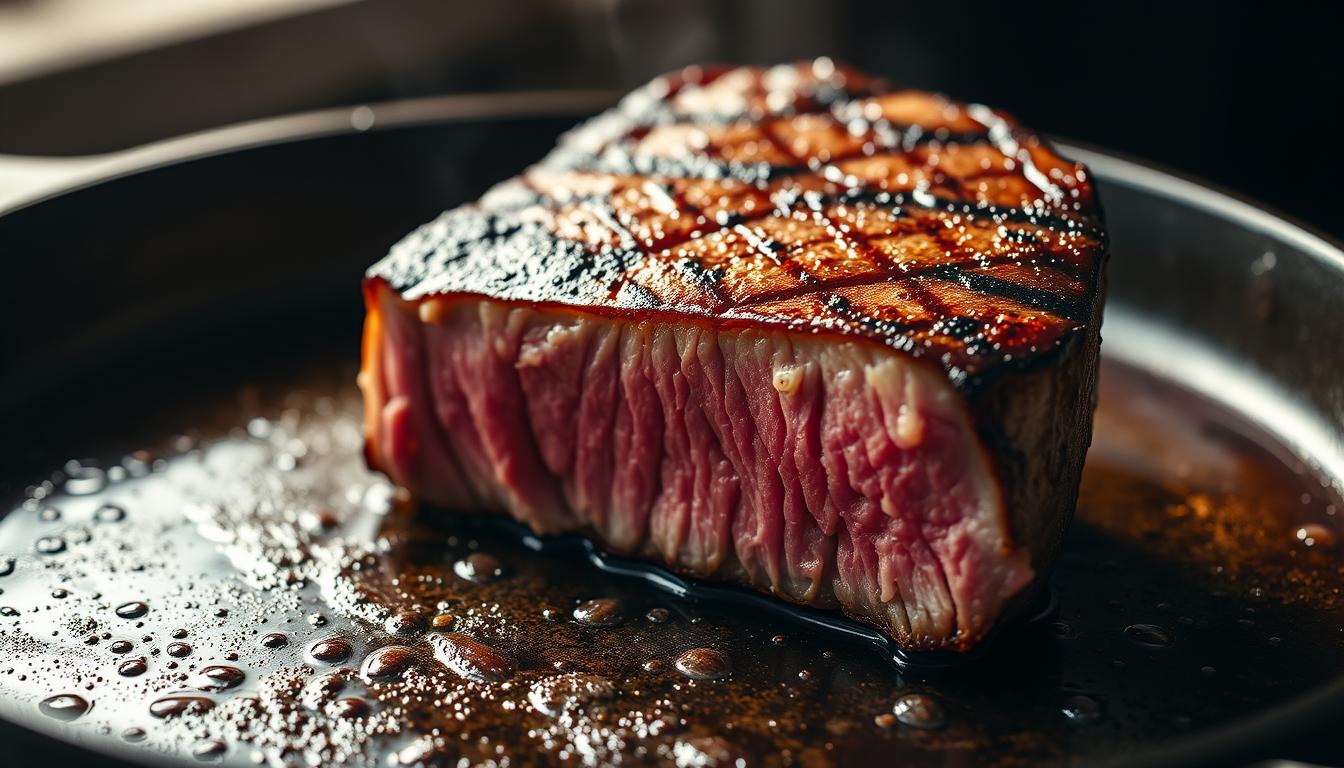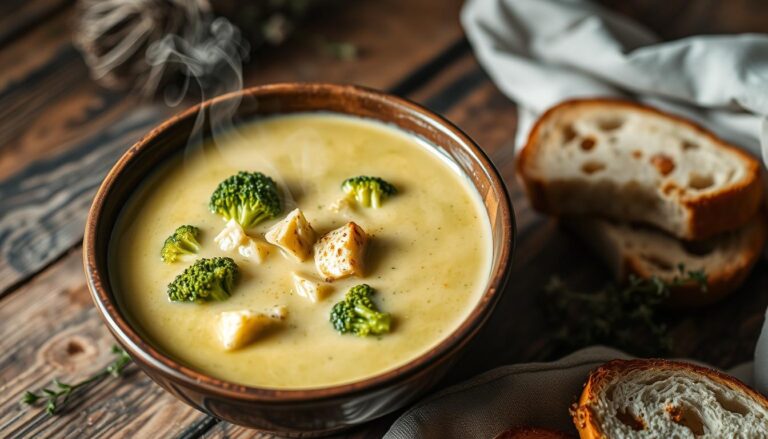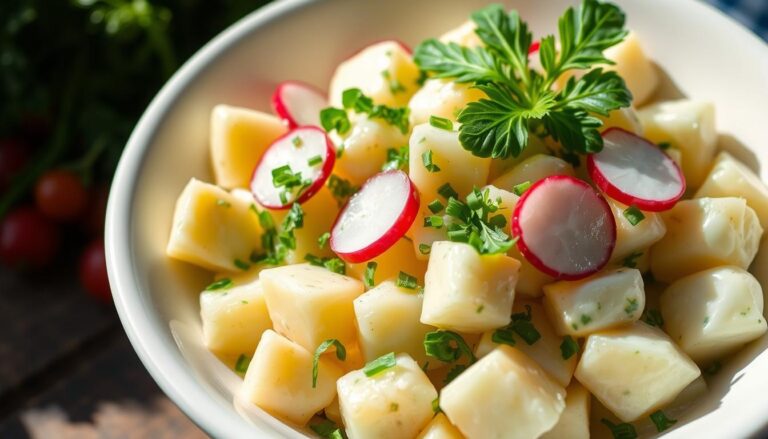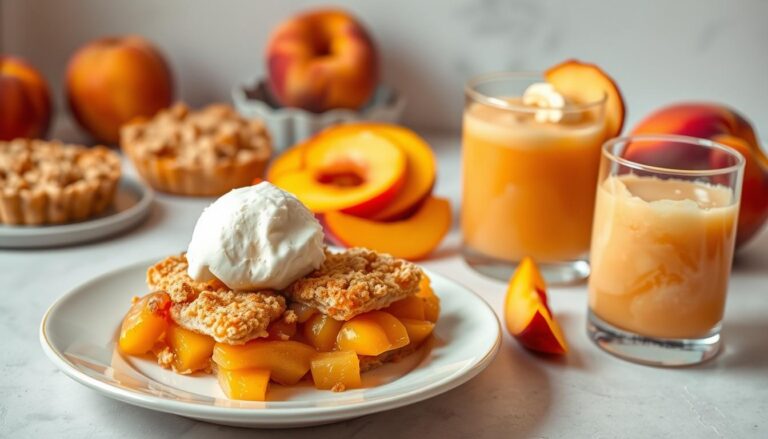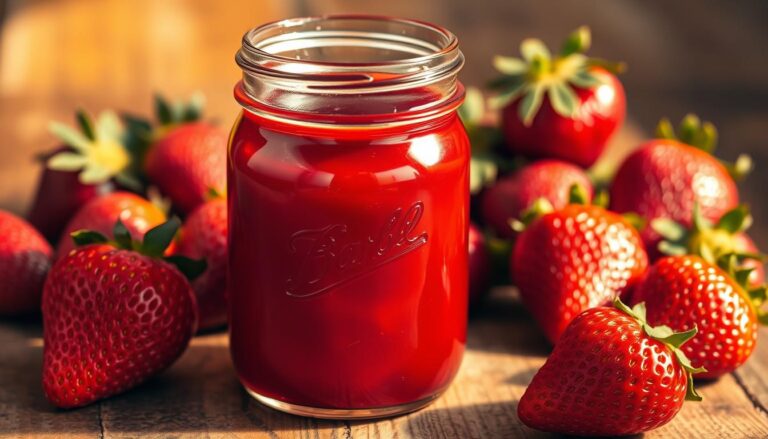Cast Iron Pan-Seared Steak (Oven-Finished)
A perfectly cooked steak is a big treat. Getting the medium rare steak temp right is what steak lovers aim for. It takes skill, good ingredients, and the right tools to cook a steak just right.
Using a cast iron pan to sear the steak and then finishing it in the oven is a top choice. This method gives you a crispy outside and a pink and juicy inside.
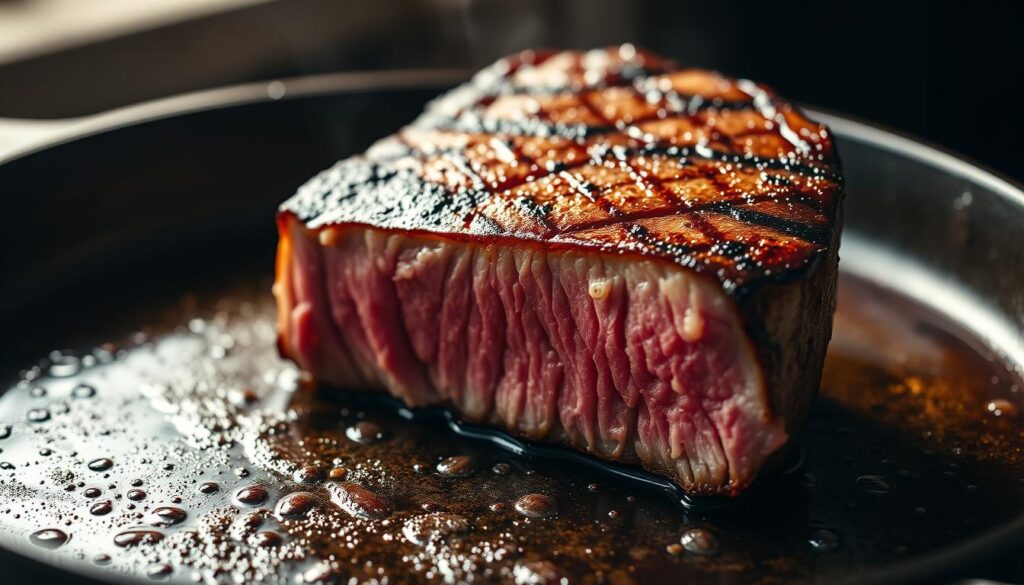
The secret to perfect steak doneness is in how you cook it. Paying close attention to temperature is key. With practice, you can make a steak that will be remembered for a long time.
Key Takeaways
- Achieving the perfect medium rare steak temp requires attention to temperature and cooking technique.
- Using a cast iron pan to sear the steak and finishing it in the oven is a great way to achieve a tender and juicy result.
- The key to perfect steak doneness is cooking technique and quality ingredients.
- A perfectly cooked steak is a culinary delight that can elevate any dining experience.
- Mastering the art of cooking steak takes practice and patience.
The Art of Perfect Steak: Pan-Searing and Oven-Finishing
Cooking a perfect steak is an art. Pan-searing and oven-finishing are key. They make the steak crispy on the outside and juicy inside.
Why This Method Creates the Best Steak
Pan-searing and oven-finishing make the best steak. They use high heat and oven cooking. This locks in juices and flavors.
The oven finish cooks the steak right. It gets to the best temperature for medium rare steak. This is between 130°F to 135°F (54°C to 57°C).
What You’ll Need for Success
To succeed, you need a few things. A cast iron pan is best for searing. It keeps heat well and makes a great crust.
A meat thermometer is also key. It makes sure the steak is cooked right. You’ll also need good steak, oil or butter, and seasonings or marinades.
Choosing the Right Cut of Steak
A great steak starts with the right cut. Pan-searing with oven-finishing brings out its best. The cut you choose greatly affects the final taste.
Best Steak Cuts for Pan-Searing
For pan-searing, pick steak cuts with good marbling and tenderness. Ribeye, strip loin, and filet mignon are top choices. Their marbling keeps the steak juicy and flavorful.
A well-marbled steak also gets a nice crust outside. This adds texture to your dish.
Think about the doneness you like. For medium rare, choose a cut with lots of marbling. It makes the steak juicy and tender.
Thickness Considerations for Oven-Finishing
The steak’s thickness is key for oven-finishing. A thin steak cooks too fast, while a thick one might not cook evenly. Aim for a steak 1-1.5 inches thick.
This thickness lets you get a good sear on the pan and a gentle oven finish. Use a meat thermometer to check the internal temperature. This ensures your steak is cooked just right, whether you want it medium rare or not.
Essential Equipment for Cast Iron Steak
To cook a steak perfectly, you need the right tools. A cast iron pan is key. It helps get a great sear and doneness.
A cast iron pan is important for steak cooking. It keeps heat well and gets a nice sear. You also need a meat thermometer and other tools for a smooth cooking process.
Selecting the Perfect Cast Iron Pan
Choosing a cast iron pan is important. Look for a thick, heavy pan. It keeps heat better. A pan with a rough surface helps make a better crust.
Make sure the pan is big enough for your steak. It should fit comfortably without being too crowded.
Meat Thermometers: Your Secret Weapon
A meat thermometer is crucial for perfect doneness. For medium rare, the steak should be between 130°F and 135°F. It makes sure your steak is juicy and safe to eat.
Additional Tools You’ll Need
Tools like tongs and a spatula help a lot. They make handling and flipping the steak easier. An oven mitt protects your hands from the hot pan.
Preparing Your Steak for Cooking
A great steak starts with proper preparation. This includes a few simple steps. First, bring the steak to room temperature. Then, add the right seasoning. Finally, think about dry brining to make it juicier.
Bringing Steak to Room Temperature
Bringing your steak to room temperature is key. Take it out of the fridge and let it sit for 30-60 minutes. This makes the steak cook evenly, as it reduces temperature differences.
Seasoning Techniques for Maximum Flavor
Seasoning is crucial for a tasty steak. Use salt, pepper, and other seasonings that match the steak’s taste. Rub both sides of the steak with these seasonings. You can also use a marinade or rub for extra flavor.
Dry Brining: The Secret to Juicy Steak
Dry brining, or pre-salting, is a secret to juicy steak. Rub the steak with salt and refrigerate it for 1-2 hours or overnight. This boosts the steak’s juices and tenderness, making it more flavorful.
Understanding Medium Rare Steak Temp and Other Doneness Levels
Cooking the perfect steak is an art. It needs knowing about cooking temperatures. The doneness of a steak is key to a great steak experience. There are levels like rare, medium rare, medium, medium well, and well done.
Each doneness level has a specific internal temperature. Knowing these temperatures helps cook steaks just right.
The Perfect Medium Rare Steak Internal Temperature
A medium rare steak is cooked to 130°F – 135°F (54°C – 57°C). This is perfect for those who love juicy and flavorful steaks. To get it right, use a meat thermometer to check the temperature.
Meat thermometers ensure the steak is safe and tender. They help keep the flavor in.
Complete Steak Doneness Temperature Chart
| Doneness Level | Internal Temperature (°F) | Internal Temperature (°C) |
|---|---|---|
| Rare | 120°F – 125°F | 49°C – 52°C |
| Medium Rare | 130°F – 135°F | 54°C – 57°C |
| Medium | 140°F – 145°F | 60°C – 63°C |
| Medium Well | 150°F – 155°F | 66°C – 68°C |
| Well Done | 160°F – 170°F | 71°C – 77°C |
The Carryover Cooking Phenomenon
Carryover cooking happens when the steak cooks a bit more after it’s off the heat. It’s important to remember this when cooking steaks. To avoid overcooking, take the steak off the heat a bit early.
Knowing about steak doneness and carryover cooking helps make the perfect steak. Steak lovers can enjoy their steaks just the way they like them.
Step-by-Step: Pan-Searing Your Steak
Getting a perfectly cooked steak starts with pan-searing. This step is key for a tender, tasty, and juicy steak. To pan-sear your steak right, preheat your cast iron pan, sear with care, and watch for visual signs of a perfect sear.
Preheating Your Cast Iron Pan Properly
Preheating your cast iron pan is very important. Heat it on high for 5-7 minutes to get it ready for searing. To check if it’s hot enough, drop a few water drops on it. If they sizzle and disappear fast, it’s ready.
A hot pan is crucial for a crust on the steak that keeps the juices in.
The Searing Process: Timing and Technique
Start by adding a bit of oil to the hot pan, then put the steak in. For a medium rare steak, sear for 2-3 minutes on each side. Don’t press down on the steak with your spatula. This can make it tough.
Let the steak cook without moving it for the right time. This helps it get a rich crust.
Visual Cues for Perfect Searing
To see if your steak is seared right, look for a golden-brown crust. The crust should be even and not too dark or too light. Also, use a meat thermometer to check the steak’s internal temperature.
For a medium rare steak, it should be between 130-135°F (54-57°C). Watching for these signs helps you cook your steak perfectly.

Transitioning to the Oven: The Finishing Touch
When we move from pan-searing to oven-finishing, the key is in the details. The oven step is key for the right doneness, especially for thicker steaks.
To get the best from oven-finishing, know the right oven temperature. Also, understand timing for steak thickness and doneness. And don’t forget to add butter and aromatics for extra flavor.
Optimal Oven Temperature Settings
A preheated oven between 300°F to 400°F (150°C to 200°C) is best for most steaks. The exact temperature depends on steak thickness and desired doneness. For medium rare, 325°F (165°C) is often the best.
For perfect steak cooking temps, use a thermometer. This ensures your oven is at the right temperature.
Timing Guidelines Based on Thickness and Doneness
The oven time for your steak depends on its thickness and doneness level. A 1-inch thick steak cooked to medium rare takes about 8-12 minutes. Here’s a guide for timing:
- 1-inch thick steak: 8-12 minutes for medium rare
- 1.5-inch thick steak: 12-15 minutes for medium rare
- 2-inch thick steak: 15-18 minutes for medium rare
When to Add Butter and Aromatics
Adding butter and aromatics in the last few minutes can make your steak taste amazing. For a deliciously cooked medium rare steak, add butter and aromatics like garlic and thyme in the last 2-3 minutes. This lets the butter melt and add flavor without burning.
Monitoring Steak Temperature While Cooking
The secret to a great steak is knowing about internal temperature. It’s key to get the perfect doneness, like medium rare. You need to watch the steak’s internal temperature closely.
To cook your steak just right, you need the right tools. A meat thermometer is very important.
Using Meat Thermometers Correctly
A meat thermometer checks the steak’s internal temperature. To use it right, put the thermometer in the steak’s thickest part. But make sure it’s not in fat or bone. For a medium rare steak internal temperature, it should be between 130°F and 135°F (54°C to 57°C).
- Check that the thermometer is set right before you start.
- Put the thermometer in the steak at an angle to miss bones and fat.
- Wait a bit until the temperature stops changing before you read it.
When to Start Checking Temperature
When to check the steak’s temperature is very important. If you’re cooking it in a cast iron pan and then in the oven, start checking when it’s almost done. For a medium rare steak, this is when it’s been in the oven for 75% to 90% of the time.
By watching the steak’s temperature and using a meat thermometer well, you can get the perfect steak doneness every time. This careful attention makes sure your steak is cooked just how you like it. Whether it’s medium rare, medium, or well done.
Resting Your Steak: The Critical Final Step
Resting your steak is a simple yet vital step. It makes your meal better. After cooking a steak, it’s tempting to cut into it right away. But, letting it rest is key for the best texture and juiciness.
Why Resting Improves Texture and Juiciness
When a steak is cooked, the fibers tighten. The juices move to the surface. Letting it rest lets the juices spread evenly through the meat.
This makes the steak tender and juicy. A rested steak tastes better and feels better in your mouth. It’s more flavorful and has a better texture than one cut too soon.
How Long to Rest Different Cuts
The resting time depends on the steak’s cut and thickness. Thinner steaks need less time, about 5-10 minutes. Thicker cuts might need 10-15 minutes or more.
For example, a ribeye or strip loin needs more time because they’re thicker. But a thinner cut like a sirloin might be ready sooner. Knowing the right resting time for your steak is important. It helps get the perfect doneness and brings out the steak’s natural flavors.
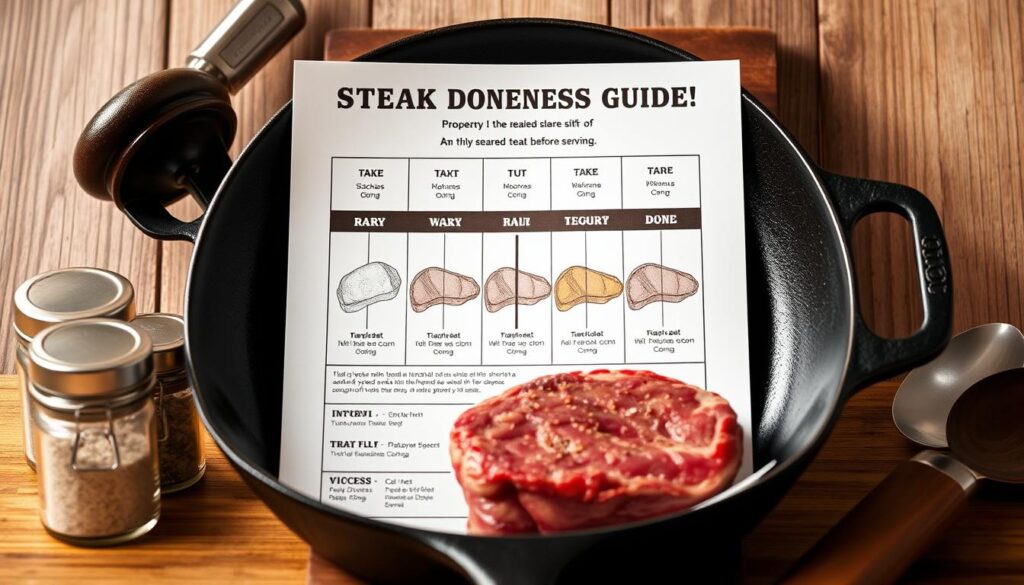
Serving Suggestions for Your Perfect Steak
Make your steak even better with our serving tips. A great steak is just the start. How you serve it can really enhance your meal.
Try adding a tasty sauce or compound butter to your steak. Béarnaise, peppercorn, or garlic butter are all yummy choices.
Complementary Sauces and Compound Butters
Sauces and butters add a creamy touch to your steak. Béarnaise sauce, made with butter, eggs, and herbs, is a classic. Peppercorn sauce adds a spicy flavor.
Compound butters like garlic or parsley butter melt over the steak, bringing out more flavor. Try different mixes to find your favorite.
Side Dishes That Pair Well with Steak
Choose the right sides to go with your steak. Roasted veggies, sautéed mushrooms, or a green salad are all great options.
For something more filling, try garlic mashed potatoes or grilled asparagus. The goal is to mix flavors and textures for a complete meal.
| Side Dish | Description |
|---|---|
| Roasted Vegetables | A colorful mix of roasted vegetables, such as asparagus, bell peppers, and zucchini. |
| Sautéed Mushrooms | Mushrooms sautéed in butter and garlic, adding an earthy flavor to the dish. |
| Garlic Mashed Potatoes | Creamy mashed potatoes infused with garlic and butter. |
Troubleshooting Common Steak Cooking Problems
Steak cooking can sometimes go wrong. You might end up with undercooked, overcooked, tough, or chewy steak. But, many problems can be fixed with simple changes.
Fixing Undercooked or Overcooked Steak
Getting the perfect doneness is a common challenge. If your steak is not right, it’s often because of the wrong internal temperature. For a medium rare steak temp, it should be 130°F – 135°F (54°C – 57°C).
Using a meat thermometer helps get it right. If it’s undercooked, just put it back in the oven or pan. This will cook it to the perfect steak cooking temps.
Dealing with Tough or Chewy Results
Tough or chewy steak is a letdown. It can happen because of the steak’s quality or how you cook it. To avoid this, pick a good cut and use a tenderizing marinade or seasoning.
Also, watch how long and at what temperature you cook it. Overcooking makes steak tough.
Smoke Management in the Kitchen
Smoke can be a problem when cooking steak, especially in a cast iron pan. To keep smoke down, make sure your kitchen is well-ventilated. Use a splatter guard or adjust the heat.
Try using avocado oil instead of other oils. It has a higher smoke point, which means less smoke.
By fixing these common steak cooking problems, you can make a steak that’s both tasty and tender. With time and practice, you’ll get better at cooking steak. You’ll be able to solve any issues that come up.
Conclusion
Getting perfect steak doneness takes practice, patience, and detail. This article shows you how to cook steaks perfectly. Knowing the medium rare steak internal temperature is key. It’s between 130°F and 135°F.
Using a meat thermometer is crucial. It helps you check the steak’s internal temperature. This ensures it’s safe and tasty. Pan-searing and oven-finishing make the steak crispy on the outside and juicy inside.
With time, you’ll get better at cooking steaks. Don’t worry if it takes a few tries. Keep trying, and you’ll cook like a pro. Follow these tips to make your steaks perfect. You’ll impress everyone with your cooking skills.
FAQ
What is the ideal internal temperature for a medium rare steak?
The perfect medium rare steak internal temperature is between 130°F and 135°F (54°C to 57°C).
How do I achieve the perfect medium rare steak temp using a cast iron pan and oven-finishing?
To get the perfect medium rare, sear the steak in a hot cast iron pan. Then, finish it in the oven at the right temperature. Use a meat thermometer to check the internal temperature.
What is carryover cooking, and how does it affect my steak’s doneness?
Carryover cooking is when the steak keeps cooking after it’s off the heat. It can make the steak reach the right doneness. So, it’s key to think about it when cooking for the perfect medium rare.
How long should I rest my steak after cooking?
Resting time varies by steak cut and thickness. Usually, 5-10 minutes is good. It lets the juices spread, making the steak tender and juicy.
What are some common mistakes to avoid when cooking steak?
Don’t forget to bring the steak to room temperature before cooking. Also, avoid overcrowding the pan and not using a meat thermometer. And, don’t forget to let the steak rest after cooking.
Can I use a different type of pan instead of cast iron for pan-searing steak?
While cast iron is best for heat retention, other pans like stainless steel or skillet work too. But, cast iron is still the top choice for a great crust.
How do I prevent my steak from becoming tough or chewy?
To avoid a tough steak, pick the right cut and don’t overcook it. Let it rest after cooking. Also, use a meat thermometer and don’t press down on the steak while it’s cooking.

